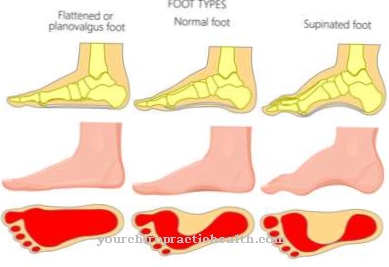A Carcinoid or neuroendocrine tumor is a slowly growing tumor disease that originates in the cells of the neuroendocrine system and usually forms in the gastrointestinal tract (appendix, stomach, small intestine, large intestine, rectum) and in the lungs.
What is a carcinoid?
.jpg)
© Kateryna_Kon - stock.adobe.com
A Carcinoid is the most common type of malignant appendage tumor in the appendix, but is most commonly associated with the small intestine, rectum, or stomach.
Metastases to the liver are usually a manifestation of a carcinoid elsewhere in the body. The second most common concern is the airways. Compared to other malignant tumors, a carcinoid grows very slowly and does not cause symptoms until late in the disease.
Only from a size of one centimeter does a carcinoid develop a malignant (malignant) character. It can produce hormones (serotonin) and release them in the body, causing symptoms such as diarrhea or reddening of the skin (carcinoid syndrome).
causes
Cancer occurs when a cell develops a mutation in its DNA. This causes abnormal cell growth. A Carcinoid develops in neuroendocrine cells - nerve cells, or hormone-producing endocrine cells, in various organs of the body.
In addition to age or a family history of multiple endocrine neoplasia type I (MEN I), smoking is another factor that increases the risk of developing a carcinoid. Pre-existing conditions such as gastritis or Zollinger-Ellison syndrome can lead to an increased risk of gastrointestinal carcinoid.
The increased production of serotonin by a carcinoid causes a breakdown of tryptophan and leads to niacin deficiency (pellagra), which can be associated with dermatitis, dementia and diarrhea.
Symptoms, ailments & signs
A carcinoid (neuroendocrine tumor) does not produce consistent symptoms. In functionally active tumors, these depend on which hormone is increased. In the case of functionally inactive tumors, there are no symptoms at the beginning. Only after a long time do they become noticeable due to their increasing size through displacement phenomena.
Depending on the location of the tumor, stomach pain, jaundice, weight loss or shortness of breath can occur. If the tumor is functionally active, however, the symptoms, which are dependent on the respective increased hormones, appear much earlier. A so-called insulinoma produces more insulin. This leads to constant hypoglycaemia with food cravings, sweating, tremors and impaired consciousness.
When the carcinoid increases the production of the hormone gastrin, it leads to increased production of stomach acid with heartburn and repeated stomach and duodenal ulcers. If the neuroendocrine tumor forms the so-called VIP hormone (vasointestinal peptide) in excess, the patient suffers from chronic diarrhea and a constant need to urinate. The increased formation of serotonin in turn leads to the so-called carcinoid syndrome, which is characterized by palpitations, sweating, attacks of reddening of the face, colicky stomach pain, breathing difficulties and diarrhea.
Most of the time, a carcinoid can be treated well because it grows very slowly. If left untreated, however, metastases develop in various organs such as the liver and bones and, less often, in the eye socket, heart muscle or chest. Large tumors can also cause life-threatening intestinal obstruction.
Diagnosis & course
A Carcinoid is in most cases asymptomatic during its lifespan and is discovered more by chance during operations for other reasons. However, every carcinoid has a malignant potential, even if it does not cause symptoms.
If symptoms arise, these are usually rather vague and depend on the location of the tumor. This includes abdominal pain, intestinal obstruction, chest pain, coughing or coughing up blood, wheezing, shortness of breath, or increased heartbeat. In particular, diarrhea, rectal bleeding or pain can indicate a carcinoid in the area of the spectrum.
There are several ways to diagnose a carcinoid. A blood test is suitable due to the increased release of hormones in the blood. If these hormones break down, increased concentrations of certain ingredients are formed, which is why a urine test can also be used.
To determine the exact location of a carcinoid, imaging tests including computed tomography (CT), magnetic resonance imaging (MRI), positron emission tomography (PET), ultrasound, octreotide scan, and x-rays are used. A carcinoid can also be located by endoscopy, bronchoscopy, or colonoscopy. A biopsy is usually done to confirm the diagnosis.
Complications
The carcinoid causes the typical symptoms and complications of cancer. The life expectancy of the person affected can also be significantly reduced if the tumor spreads to other areas of the body or is only recognized late. Those affected suffer from severe shortness of breath and also from a cough.
In addition, there is an ulcer in the stomach, which often leads to abdominal pain and weight loss. Jaundice can also occur and indicate problems with the liver. The patient's quality of life is generally significantly reduced and restricted by the carcinoid. It can also lead to a so-called intestinal obstruction or an increased heartbeat.
Chest pain can also occur due to the shortness of breath and make everyday life more difficult for the person concerned. Treatment is usually done with chemotherapy or radiation. Most tumors can be removed in this way. The further course of the disease, however, depends on the spread of the cancer, so that no general prediction is possible. In most cases, however, life expectancy is significantly reduced due to the carcinoid.
When should you go to the doctor?
Signs such as rapid heartbeat, difficulty breathing or cramps indicate a serious health problem. A doctor's visit is necessary so that the cause of the irregularities can be clarified and treated. Consult a doctor in the event of abdominal pain, diarrhea, or weight loss. If persistent and incomprehensible coughing fits, difficulty swallowing, expectoration or shortness of breath occur, a doctor must be consulted. A tremor in the body, pale skin or discoloration of the skin should be examined medically. Yellowing of the skin is a particular cause for concern.
Since, without treatment, there is a risk of organ failure and premature death of the person affected, a visit to a doctor is advisable as soon as the first signs of the disease are given. If existing symptoms persist or if they become more severe, a medical check-up should be made immediately. If the face, neck or décolleté has an attack-like, inexplicable reddening, a doctor should be informed of the observations. The so-called flush is a special symptom that indicates the presence of the carcinoid. In rare cases, there is a loss of consciousness and thus fainting. An emergency doctor must be contacted so that intensive medical treatment can be initiated as soon as possible.
Treatment & Therapy
Treating a Carcinoides depends on the location of the tumor, the spread, the general state of health and the stage of the disease.
The only curative therapy for a carcinoid is surgery that can remove a carcinoid completely. If the carcinoid has metastasized, forms of treatment such as radioactively labeled octreotide or the radiopharmaceutical 131I-MIBG (meta-iodo-benzyl guanidine) are used to arrest the growth of cancer cells and embolization techniques.
Radiofrequency ablation is used to create heat treatments that kill a carcinoid. Chemotherapy is of little use for a stray carcinoid and is usually not initiated. The administration of octreotide or lanreotide (somatostatin analogues) can reduce the secretory activity of a carcinoid and also has a growth-inhibiting effect.
Alternative therapies can help manage cancer treatment and control the stress it creates, as well as coping with the diagnosis of carcinoid. These include massage, meditation or relaxation techniques such as tai chi and yoga.
You can find your medication here
➔ Medicines for stomach ailments and painOutlook & forecast
A carcinoid is usually a well-differentiated neuroendocrine tumor. Since this only grows slowly, a good prognosis can be expected if it is detected early. Furthermore, the course of the disease of a carcinoid depends largely on the type and location of the tumor. Neuroendocrine tumors of the appendix often do not form daughter tumors. Because of this, they have more favorable prognoses than other gastrointestinal carcinoids.
A prerequisite, however, is adequate treatment that includes removal of the appendix and drug therapy. If the treatment is successful, patients can expect a cure. In general, the 5-year survival rate in this case is given as 75%. However, untreated or late recognized carcinoids can take a malignant course. The malignant manifestation is characterized, among other things, by the formation of metastases. In addition, those affected with poorly differentiated or malignant carcinoids have a significantly reduced life expectancy.
In order to improve the prognosis of the malignant neuroendocrine tumor, prompt removal of the primary tumor is the method of choice. Furthermore, the life expectancy can be further increased by a subsequent chemotherapy. These and additional measures can often stop the disease from progressing for several years.
prevention
A targeted prophylaxis against a Carcinoid cannot currently be recommended. Doctors therefore refer to a healthy lifestyle with plenty of fresh fruit and vegetables and a low stress level. If a carcinoid is diagnosed, serotonin-rich foods should be avoided.
Aftercare
After cancer therapy is followed by regular follow-up care. This is intended to identify the recurrence as early as possible, from which doctors promise better treatment options. Metastases can form in neighboring organs, for example. This concern also applies to carcinoids.
Follow-up examinations usually take place in the clinic where the initial therapy was started. The doctor agrees a rhythm for follow-up care with his patient. This runs closely in the first year and then expands from year to year. Quarterly inspections must initially be observed at least. After the fifth year, annual follow-up is usually sufficient. The likelihood of a tumor recurrence has decreased immensely at this point.
The type of follow-up for a carcinoid depends on the specific disease. Blood and urine tests as well as imaging tests are possible. The latter include sonography, endoscopy, CT and MRI. Follow-up care also aims to support the patient. Social, psychological and physical complaints resulting from the illness are treated in one therapy. Due to their professional orientation, rehabilitation facilities promise a comparatively quick return to everyday life.
You can do that yourself
Depending on where the tumor is located and the general state of health of the patient, various measures can be taken for treatment.
First of all, tumor patients should take it easy and avoid stress if possible. Under certain circumstances, chemotherapy or radiation therapy can be supported by a change in diet. Which dietary measures are sensible and necessary depends entirely on the stage of the disease. The sick person should work out an individual nutrition plan together with the doctor. After the initial treatment, moderate exercise is recommended. Exercise strengthens the immune system and improves wellbeing. Attending a self-help group can also be useful. Not only the sick themselves, but also the relatives often need emotional support. This can also be done by a therapist.
Alternative therapies can help against the stress that cancer treatment brings with it. These include, for example, massages, meditation, relaxation techniques such as yoga and acupuncture. To make it easier to deal with the diagnosis of carcinoid, it can also help to get as much information as possible about the disease. The doctor can advise the patient of other options for surviving the illness and the symptoms that are associated with it.






.jpg)






.jpg)

.jpg)
.jpg)











.jpg)